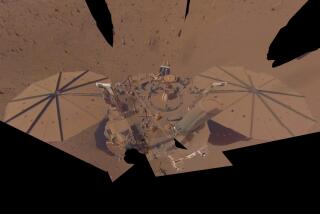It’s true: There is water on Mars
- Share via
After weeks of testing the soil in the Martian arctic, NASA’s Phoenix lander has for the first time confirmed through chemical analysis the presence of water on another planet, scientists said Thursday.
Several weeks ago, Phoenix uncovered convincing visual evidence that it had landed on an ice field when it set down on Mars’ northern plain May 25.
Pictures beamed back to Earth across 200 million miles showed white streaks in the lumpy soil around the lander, and a tool on the lander’s robotic arm had shaved off chunks of the material that scientists were certain was ice.
On Thursday, the Phoenix team -- consisting of scientists from NASA and the University of Arizona -- presented evidence that material baked in one of Phoenix’s eight tiny ovens was indeed water, the first time any spacecraft from Earth had tasted the life-giving substance on another world.
The evidence came from a mass spectrometer on Phoenix’s thermal and evolved-gas analyzer, or TEGA. When heated, the targeted material in the soil melted at the expected temperature, which Phoenix scientist William Boynton called definitive proof.
“The fact that it melted at 0 degrees centigrade leaves very little doubt” that it is water, said Boynton, speaking at a news conference in Tucson.
For Phoenix scientists, the challenge hasn’t been finding the ice but getting it into one of the testing ovens.
The ovens are only about the width of a pen cartridge. Getting soil in there was difficult because it proved to be clumpy. Scientists finally got one sample of soil in an oven several weeks ago by dribbling it in.
Getting the ice in was even harder. It tended to either vaporize or stick to the scoop on the robotic arm.
Over recent days, the scientists had grown so frustrated with the failure to transfer bits of ice into the oven that they gave up and decided to put another soil sample into a second oven. When they performed the first of four heat tests on the material, the mass spectrometer on the instrument detected a change at the melting point of ice.
“We’ve gotten an ice sample into TEGA,” said a smiling Boynton. “It tastes very fine.”
The amount of ice in the soil sample is tiny, probably about 1% of the total, Boynton said. In the next few days, the TEGA instrument will gradually heat the sample to a temperature of 1,800 degrees Fahrenheit, testing the gases given off along the way for the presence of organic chemicals, the building blocks of life as humans understand it.
It could be weeks before the Phoenix team is finished with the analysis. In the meantime, the scientists will try to perfect the ice delivery method to obtain a larger sample.
Also Thursday, NASA said it was extending the Phoenix mission by a month beyond the 90 days previously announced. The mission has completed 65 sols, or Martian days.
It is high summer on Mars, but in a few months winter will set in, covering the lander in a thick coat of carbon dioxide ice, snuffing out its life.
--
More to Read
Sign up for Essential California
The most important California stories and recommendations in your inbox every morning.
You may occasionally receive promotional content from the Los Angeles Times.













